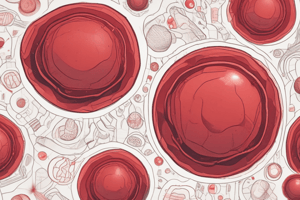Podcast
Questions and Answers
What is one of the primary functions of red blood cells (RBCs)?
What is one of the primary functions of red blood cells (RBCs)?
- Produce antibodies
- Store vitamin D
- Enclose hemoglobin (correct)
- Transport nutrients
The biconcave shape of RBCs enables them to pass through narrow capillaries without rupture.
The biconcave shape of RBCs enables them to pass through narrow capillaries without rupture.
True (A)
What enzyme do RBCs contain that catalyzes the reaction between water and carbon dioxide?
What enzyme do RBCs contain that catalyzes the reaction between water and carbon dioxide?
Carbonic anhydrase
The normal diameter of a red blood cell (RBC) is ______ micrometers.
The normal diameter of a red blood cell (RBC) is ______ micrometers.
Match the following RBC attributes with their correct descriptions:
Match the following RBC attributes with their correct descriptions:
Flashcards are hidden until you start studying
Study Notes
Function of RBCs
- RBCs enclose hemoglobin, which enables them to carry oxygen and carbon dioxide.
- Hemoglobin in RBCs carries O2 and CO2.
- RBCs contain carbonic anhydrase, an enzyme that catalyzes the reaction between H2O and CO2.
RBC Characteristics
- Adult males have 5-5.5 million RBCs per mm3.
- Adult females have 4.5-4.8 million RBCs per mm3.
- Newborn infants have a higher number of RBCs.
- RBCs are circular, biconcave, non-nucleate discs.
- The biconcave shape of RBCs increases their surface area in relation to volume.
- The biconcave shape of RBCs enables them to pass through narrow capillaries without rupture.
- RBCs have a volume of 90 µ3.
- RBCs have a diameter of 7.5 µ.
- RBCs have a thickness of 2 µ.
Studying That Suits You
Use AI to generate personalized quizzes and flashcards to suit your learning preferences.



